Heather Zeiger makes an argument for why the earth and the universe are so fine-tuned for life.
Answering the Big Questions of Life
Let’s pretend that you go outside to find your front yard full of trash and debris. The first question that probably comes to mind is, “Did someone do this on purpose, or was this an accident?” In hopes of determining a cause, you begin by looking at clues. Does the neighbor’s yard have debris in it? If so, then it’s possible the wind blew the trash and debris into both your yards. If not, then you become suspicious. Why are you suspicious? The probability that the wind would blow trash in your yard, but not your next door neighbor’s yard is low. But it is possible, so you look for more clues. Upon further examination you find that the debris stops right at the property line between your yard and your neighbor’s yard. This makes you even more suspicious because the probability of this happening by chance is now lower than it was before. Although you were not there to see the trash thrown in your yard, you are fairly certain someone did this on purpose. Although you may intuit the cause, the reason why you assume foul play is because with each clue comes a probability of its occurrence. With multiple clues, the probabilities multiply, so finding two clues that are improbable makes the entire event even more improbable.
Taking our scope beyond your backyard to the earth and to the universe, the question becomes, “Why are the universe and earth here after all? Why is it the way it is?” When it comes down to it, just like with your front yard, we are left with two causal options: either life, the universe, and everything in between were put here on purpose, or it was an accident.
Every effect has a cause, but if we take cause and effects back far enough, eventually we will find something that is eternal or the ultimate cause. Therefore, we have two options: either that eternal thing is natural or it is supernatural. Or put another way, either the universe itself (or at least the matter and energy that makes up the universe) is eternal, or something outside of the universe and nature is eternal.
This article will look at the clues within our universe that will help us answer whether the universe arose by accident or was put here on purpose. We will be looking at some very improbable fine-tuned parameters that not only allow for stars and galaxies to be here, but also parameters that allow for life. Finally we will look at parameters that seem to be in place not just for any life, but for us in particular.
Not to give away the ending, but the Bible tells us that “the heavens declare the glory of God,”{1} and it turns out there are some clues that seem to indicate intentionality or purpose in design. However, the Bible also says that man will suppress the truth. So even though the clues seem to point towards design, we will see examples of how some scientists explain these clues without invoking any kind of designer or supernatural agent. Basically, we will see how they can still have an eternal universe instead of something eternal that is outside of the universe.
The Fine-Tuned Parameters for Life{2}
Physicists have concluded that certain features of the universe have to be almost exactly as they are, otherwise the universe wouldn’t be here. For example, the universe is expanding outward. If it expanded any faster, it would overcome gravity, and galaxies, stars, and planets would fly apart. If it expanded any slower, gravity would take over and everything would come crashing back together.
On a much smaller scale, the same idea applies to the atom. When asked what he was thankful for, a friend of mine replied, “That my atoms don’t just explode.”{3} If you think about it, why don’t our atoms just fly apart? Just like the expanding universe, the properties of protons, neutrons, and electrons are just right so that the electrons don’t come crashing into the atom or the atom doesn’t fly apart. Without atoms, nothing would be here, and yet the forces that hold the atom together are apparently so balanced that they seem to be resting on a knife’s edge.
Not only is our universe fine-tuned for existence, but the earth is fine-tuned for life. You may not realize this, but water is a unique substance with very uncommon properties. Most substances are denser when they are a solid than when they are a liquid, but water is not. It is denser as a liquid, so we observe ice floating instead of sinking. What’s the big deal? The big deal is that we need this property to survive. The ocean has an entire ecosystem including plants and bacteria. The oceanic plants and bacteria account for a large amount of oxygen in our atmosphere. Thanks to water freezing from the top down, these organisms can continue to live underwater, even if the top of the water is frozen.
Interestingly, Earth is in just the right temperature range for water to be a liquid. This is a very narrow temperature range compared to the ranges for steam or ice. Given all of the possible temperatures and pressures in the universe, you will most likely find water as a solid or a gas. But Earth just happens to be in that narrow range for water to occur as a liquid. Considering that we need water to survive, I find this rather convenient.
Physicists have come to the conclusion that the universe is remarkably fine-tuned. There are constants, such as the gravitational constant or the gas constant, that are just the right values for life. Gravity and the atomic forces seem to be perfectly balanced for life. So the question is, what does this remarkable fine tuning mean? Is there someone who has set the dials of the universe to make it just right for us? Or is this the result of random chance?
Goldilocks Explains Fine-Tuning
The fine-tuned parameters of the universe that allow for its existence and allow for life are highly improbable. Many people try to explain away these very improbable factors by appealing to chance or natural laws. But the fine-tuned factors are so improbable that they would seem to be impossible.
One way to try to explain this is to assume that maybe the universe is infinite; after all, given an infinite amount of time, even the improbable can become possible, right? It turns out the universe is not infinite. Physicists have concluded, using evidence from Erwin Hubble’s studies and Einstein’s theories, that the universe had a beginning that they call the Big Bang.
If scientists want to appeal to chance, they are confined to a given amount of time. However, the fine-tuned parameters are so improbable that even fifteen billion years is not enough time. Some scientists try to find a way to have an infinite universe anyway because they wish to circumvent the God question.{4} The only way to do this, given fine-tuning, is to increase your probabilistic occurrences. The most popular theory is the multiverse or many universes theory. This idea is that there are many universes, and the one we’re in happens to be well-suited for life. Our fine-tuned parameters are not fine-tuned at all; they are just one set among many sets of parameters, each within its own universe.
Remember Goldilocks and the three bears? “This porridge is too hot . . . this porridge is too cold . . . this porridge is just right!” Given three options, Goldie found one that was just right. According to multiverse theory, there are an infinite number of universes: some too hot, some too cold. But if there are an infinite number to choose from, certainly one must be just right.
However, there is no evidence for there being any universes other than our own. Physicists readily admit that we do not have access to the other universes, but we must assume they are there. Essentially, they have constructed a theory that postulates something infinite and beyond ourselves, something wholly other than our universe and not necessarily measurable from our finite perspective. It seems that in order to get away from a creator, physicists have posed a theory which appeals to something that we can never know to be true and must take on faith. But unlike the Christian faith, this is faith in something that has no evidence of its existence.
String Theory Explains Everything . . . or Nothing{5}
Many scientists want to find a mathematical theory of everything in hopes that maybe this will answer the question as to why the universe is here.
Scientists have several theories to explain how the major forces interact with each other. There are theories for electricity and magnetism and for the forces that hold an atom together. But the one thing that still has physicists baffled is gravity. How do we explain gravity in relation to these other forces? Some scientists believe that if we can find a way to relate gravity to all of the other forces, then maybe we will understand how the universe came into existence.
In the last twenty years, physicists have developed a theory called string theory that tries to combine gravity and quantum mechanics. String theory began by describing the parts that make up protons (known as hadrons) as particles that behave as if they are on the ends of strings. The mathematics for this looks a lot like that of harmonic oscillators (springs). However, these strings are not particles, they are strings of energy. Okay, reasonable enough. We know that electrons and photons act like both particles and waves, and one can think of these strings as standing waves. But because of issues with the mathematics, either everything has to be fundamentally made up of strings of energy or nothing.
String theory mathematics, though, led to some interesting features, including the fact that there has to be ten dimensional space, not our normal three dimensions plus time. So those other dimensions either have to be hiding somewhere or the math fails. Scientists have proposed theories that describe the other dimensions as being “compacted.”
String theory math is complex and perhaps inelegant, but it is compelling because it does a better job than any other theory of relating gravity to quantum mechanics. I think there is some promise to the ideas of string theory, but scientists seemed too eager to make it a theory of everything in hopes that the purpose of the universe can be explained through mathematics and physical laws. We can never really be sure of the validity of string theory because it is impossible to test it experimentally.{6} However, we should note that scientists don’t escape the fine tuning issue. String theory math works in ten dimensions and ten dimensions only. So string theory is itself finely tuned. Fine tuning doesn’t arise from it. In fact, any equation or theory of everything would still be fine tuned. It seems to point towards a designer (or Mathematician, if you would prefer).
Ultimately, natural laws or equations cannot explain fine tuning because it still boils down to this question: Are the laws put here on purpose or did they arise by chance? If you refuse purpose, then you are left with chance.
Fine-Tuned for Life and for Discovery
What if the fine tuning of the universe is the result of some kind of design or something supernatural beyond our universe? Does this hypothesis help explain some other inexplicable coincidences? It seems that if the universe and earth were designed for life, maybe it was also designed, not just for organic life, but with us intellectual beings in mind.
The fine-tuned parameters of the universe beg to be explained. However, as William Lane Craig says, explaining these observations puts the physicist in the realm of philosophy because he is trying to explain the purpose for the observation of fine-tuning. “The theistic philosopher can therefore without apology or embarrassment introduce his metaphysical commitment to theism as an at least equally plausible, if not superior, alternative explanation to metaphysical, naturalistic accounts of the complex order of the universe.”{7}
The fine-tuning of life seems to point to some of the attributes of God. Psalm 19 says, “The heavens declare the glory of God, and the sky above proclaims his handiwork.”
This perspective has explanatory power.{8} We are able to explain things that naturalists have passed off as a coincidence. For example, the earth’s moon is important for life because it affects the tides which circulate nutrients in the ocean. But the moon also happens to be the perfect size such that from the Earth’s viewpoint, it can completely block out the sun [during an eclipse]. The sun is 400 times farther away from the earth than the moon, but it is also 400 times larger. In other words, the moon’s size is exactly proportional to the Earth’s distance from the sun. This isn’t needed for life, but it is needed for discovery. Thanks to total solar eclipses, relativity theory was confirmed. We have also learned about the composition of the sun, the activity of the sun, and many other features of our sun.
And if that isn’t suspicious enough, it turns out the Earth is in a perfect position in our galaxy to study astronomy. If we were anywhere other than in between two of the spiral arms of the Milky Way, the sky would be too bright to use telescopes.
And what about our atmosphere? Yes, the Earth’s atmosphere has the perfect balance of nitrogen, oxygen, hydrogen, and carbon dioxide to allow for life, but it also happens to be clear enough to allow us to look out into the heavens. All of this might be attributed to chance coincidences, but if we allow that the universe was designed for life, then perhaps it was designed with us in mind. And why not? Psalm 8 says, “When I look at Your heavens, the work of Your fingers, the moon and the stars, which You have set in place, what is man that You are mindful of him?”{9} But the Psalm continues by describing man as very valuable to God; he is only a little lower than the heavenly beings, and God has crowned him with glory and honor.
The scientific observations tell us that the universe and the Earth seem remarkably fine-tuned for life and for discovery. Investigation of these clues seems to point towards some kind of purpose and design. If we take what we observe in nature with what is revealed in Scripture, there is compelling reasons to believe that God created the heavens and the earth, and He created them with us in mind.
Notes
1. Psalm 19:1 (ESV)
2. This section is a survey of common fine-tuned parameters taken from The Privileged Planet by Guillermo Gonzales and Jay W. Richardson. For a list of the fine-tuned parameters, see Reasons to Believe: www.reasons.org.
3. Quote from Todd Kappelman, Research Associate, Probe Ministries.
4. See Leonard Susskind, “Introduction,” in The Cosmic Landscape (Back Bay Books, 2006).
5. The information from this section comes from Susskind, The Cosmic Landscape; Brian Greene, The Elegant Universe (Vintage Books, 2000); and articles by William Lane Craig.
6. We can never “see” a string because we do not have the technological capacity to study something that is that small (known as a Plank length), so there is no experimental way to confirm string theory by finding strings. Brian Greene identifies certain experimental possibilities if we had just a little more knowledge. These experiments could be evidence for string theory since they are based on presupposing strings. See his The Elegant Universe, chapter 9).
7. “The Teleological Argument and the Anthropic Principle” by William Lane Craig www.reasonablefaith.org/site/News2?page=NewsArticle&id=5179
8. Examples of how the universe is fine-tuned for discovery are taken from The Privileged Planet by Jay W. Richards and Guillermo Gonzales.
9. Psalm 8:4 (ESV)
Additional References for String Theory:
String Theory is a complex theory. This article only touches the surface. Two sources that do a good job of explaining string theory without delving into the mathematics are:
• The Cosmic Landscape by Leonard Susskind
• The Elegant Universe by Brian Greene
Both of these books are from a naturalistic worldview. While they are both good descriptions of string theory, Greene and Susskind take their theory beyond the realm of science and into the realm of philosophy and, I believe, make the implications of string theory into something more than it is. They also are forthright in their hope that string theory will solve the “problem” of an apparently fine-tuned universe.
Christian perspectives on string theory and multiverse theory:
• “Does God Exist?” by William Lane Craig
www.reasonablefaith.org/site/News2?page=NewsArticle&id=5507
• “Subject: Multiverse and the Design Argument” Q/A with William Lane Craig
www.reasonablefaith.org/site/News2?page=NewsArticle&id=5741
• Reasons to Believe’s series on string theory:
www.reasons.org/astronomy/string-theory
Related Probe articles:
• Answer to Email: “What Do You Think of the Many Universes Theory?”: www.probe.org/what-do-you-think-of-the-many-universes-theory/
• “Are We Significant in This Vast Universe?” [Steve Cable] www.probe.org/are-we-significant-in-this-vast-universe/
• “There is a God” [Michael Gleghorn]: www.probe.org/there-is-a-god/
• Big Bang and a Just Right Universe (“The Origin of the Universe”) [Rich Milne]: www.probe.org/the-origin-of-the-universe/
• “The Case for a Creator” [Gene Herr]: www.probe.org/the-case-for-a-creator/
© 2010 Probe Ministries
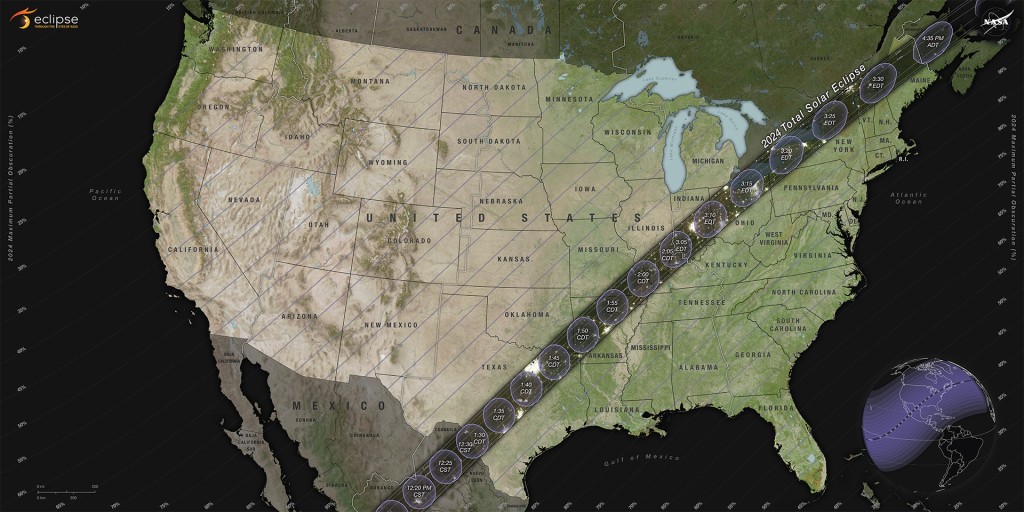
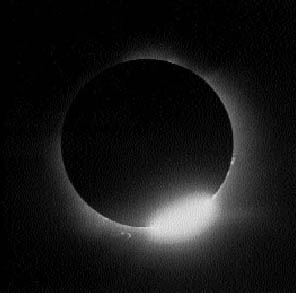 During an eclipse, the heavens declare the glory of God by allowing us to see things about the sun we wouldn’t be able to observe any other way, beautiful and gloriously resplendent. Just before totality we can see “Baily’s Beads.” Only seen during an eclipse, bright “beads” appear at the edge of the moon where the sun is shining through lunar valleys, a feature of the moon’s rugged landscape. This is followed by the “diamond ring” effect, where the brightness of the sun radiates as a thin band around the circumference of the moon, and the last moments of the sun’s visibility explode like a diamond made of pure light. After the minutes of totality, the diamond ring effect appears again on the opposite side of the moon as the first rays of the sun flare brilliantly. These sky-jewelry phenomena are so outside of mankind’s control that witnessing them stirs our spirits (even on YouTube!) with the truth of Romans 1:20—”God’s invisible qualities—his eternal power and divine nature—have been clearly seen, being understood from what has been made, so that people are without excuse.”
During an eclipse, the heavens declare the glory of God by allowing us to see things about the sun we wouldn’t be able to observe any other way, beautiful and gloriously resplendent. Just before totality we can see “Baily’s Beads.” Only seen during an eclipse, bright “beads” appear at the edge of the moon where the sun is shining through lunar valleys, a feature of the moon’s rugged landscape. This is followed by the “diamond ring” effect, where the brightness of the sun radiates as a thin band around the circumference of the moon, and the last moments of the sun’s visibility explode like a diamond made of pure light. After the minutes of totality, the diamond ring effect appears again on the opposite side of the moon as the first rays of the sun flare brilliantly. These sky-jewelry phenomena are so outside of mankind’s control that witnessing them stirs our spirits (even on YouTube!) with the truth of Romans 1:20—”God’s invisible qualities—his eternal power and divine nature—have been clearly seen, being understood from what has been made, so that people are without excuse.”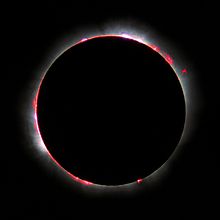 A total solar eclipse offers so much more, though, than Baily’s Beads and the Diamond Ring. At the moment of totality, the pinkish arc of the sun’s chromosphere (the part of the sun’s atmosphere just above the surface) suddenly “turns on” as if an unseen hand flips a switch. I knew God is very fond of pink because of how He paints glorious sunrises and sunsets in Earth’s skies, but those fortunate enough to see a total eclipse can see how He radiates pinkness from the sun itself! The heavens declare the glory of God!
A total solar eclipse offers so much more, though, than Baily’s Beads and the Diamond Ring. At the moment of totality, the pinkish arc of the sun’s chromosphere (the part of the sun’s atmosphere just above the surface) suddenly “turns on” as if an unseen hand flips a switch. I knew God is very fond of pink because of how He paints glorious sunrises and sunsets in Earth’s skies, but those fortunate enough to see a total eclipse can see how He radiates pinkness from the sun itself! The heavens declare the glory of God!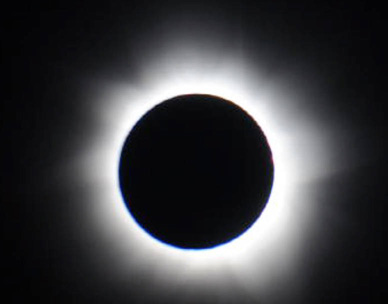 For the few minutes of totality, the naked eye can see the sun’s lovely corona (Latin for crown) streaming out from the sun. We can’t see the corona except during an eclipse because looking straight at the sun for even a few seconds causes eye damage, and because the sun’s ball of fire overwhelms the (visually) fragile corona. This is another way that an eclipse allows us to see how the heavens declare the glory of God.
For the few minutes of totality, the naked eye can see the sun’s lovely corona (Latin for crown) streaming out from the sun. We can’t see the corona except during an eclipse because looking straight at the sun for even a few seconds causes eye damage, and because the sun’s ball of fire overwhelms the (visually) fragile corona. This is another way that an eclipse allows us to see how the heavens declare the glory of God.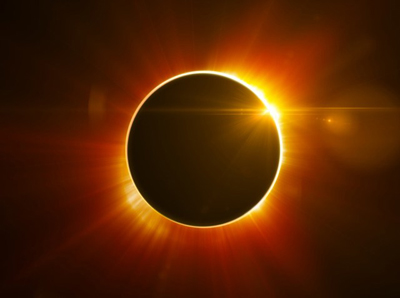 “The heavens declare the glory of God,” Psalm 19 tells us. On August 21, 2017, millions of Americans will have an incredible opportunity to see His heavenly glory in a way most of us never have: through a total solar eclipse. On a path running from Oregon to South Carolina, observers on the ground will see the moon slip in front of the sun, blocking out all its light and dropping the temperature drastically (about 10 to 15 degrees Fahrenheit) and suddenly.
“The heavens declare the glory of God,” Psalm 19 tells us. On August 21, 2017, millions of Americans will have an incredible opportunity to see His heavenly glory in a way most of us never have: through a total solar eclipse. On a path running from Oregon to South Carolina, observers on the ground will see the moon slip in front of the sun, blocking out all its light and dropping the temperature drastically (about 10 to 15 degrees Fahrenheit) and suddenly. During an eclipse, the heavens declare the glory of God by allowing us to see things about the sun we wouldn’t be able to observe any other way, beautiful and gloriously resplendent. Just before totality we can see “Baily’s Beads.” Only seen during an eclipse, bright “beads” appear at the edge of the moon where the sun is shining through lunar valleys, a feature of the moon’s rugged landscape. This is followed by the “diamond ring” effect, where the brightness of the sun radiates as a thin band around the circumference of the moon, and the last moments of the sun’s visibility explode like a diamond made of pure light. After the minutes of totality, the diamond ring effect appears again on the opposite side of the moon as the first rays of the sun flare brilliantly. These sky-jewelry phenomena are so outside of mankind’s control that witnessing them stirs our spirits (even on YouTube!) with the truth of Romans 1:20—”God’s invisible qualities—his eternal power and divine nature—have been clearly seen, being understood from what has been made, so that people are without excuse.”
During an eclipse, the heavens declare the glory of God by allowing us to see things about the sun we wouldn’t be able to observe any other way, beautiful and gloriously resplendent. Just before totality we can see “Baily’s Beads.” Only seen during an eclipse, bright “beads” appear at the edge of the moon where the sun is shining through lunar valleys, a feature of the moon’s rugged landscape. This is followed by the “diamond ring” effect, where the brightness of the sun radiates as a thin band around the circumference of the moon, and the last moments of the sun’s visibility explode like a diamond made of pure light. After the minutes of totality, the diamond ring effect appears again on the opposite side of the moon as the first rays of the sun flare brilliantly. These sky-jewelry phenomena are so outside of mankind’s control that witnessing them stirs our spirits (even on YouTube!) with the truth of Romans 1:20—”God’s invisible qualities—his eternal power and divine nature—have been clearly seen, being understood from what has been made, so that people are without excuse.” A total solar eclipse offers so much more, though, than Baily’s Beads and the Diamond Ring. At the moment of totality, the pinkish arc of the sun’s chromosphere (the part of the sun’s atmosphere just above the surface) suddenly “turns on” as if an unseen hand flips a switch. I knew God is very fond of pink because of how He paints glorious sunrises and sunsets in Earth’s skies, but those fortunate enough to see a total eclipse can see how He radiates pinkness from the sun itself! The heavens declare the glory of God!
A total solar eclipse offers so much more, though, than Baily’s Beads and the Diamond Ring. At the moment of totality, the pinkish arc of the sun’s chromosphere (the part of the sun’s atmosphere just above the surface) suddenly “turns on” as if an unseen hand flips a switch. I knew God is very fond of pink because of how He paints glorious sunrises and sunsets in Earth’s skies, but those fortunate enough to see a total eclipse can see how He radiates pinkness from the sun itself! The heavens declare the glory of God! For the few minutes of totality, the naked eye can see the sun’s lovely corona (Latin for crown) streaming out from the sun. We can’t see the corona except during an eclipse because looking straight at the sun for even a few seconds causes eye damage, and because the sun’s ball of fire overwhelms the (visually) fragile corona. This is another way that an eclipse allows us to see how the heavens declare the glory of God.
For the few minutes of totality, the naked eye can see the sun’s lovely corona (Latin for crown) streaming out from the sun. We can’t see the corona except during an eclipse because looking straight at the sun for even a few seconds causes eye damage, and because the sun’s ball of fire overwhelms the (visually) fragile corona. This is another way that an eclipse allows us to see how the heavens declare the glory of God.